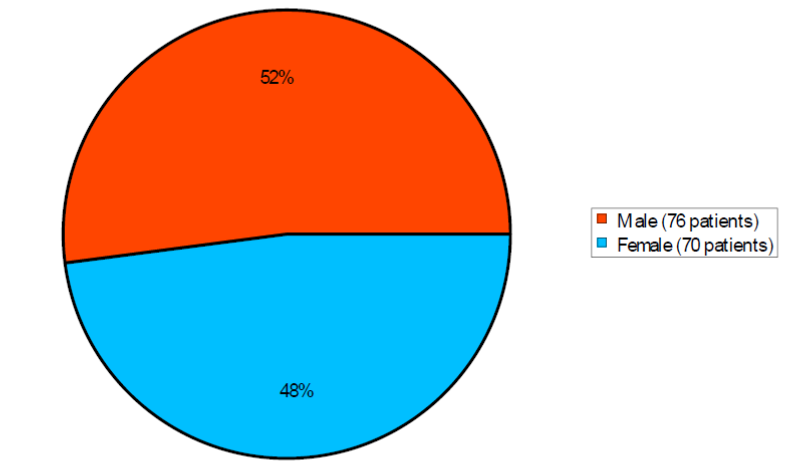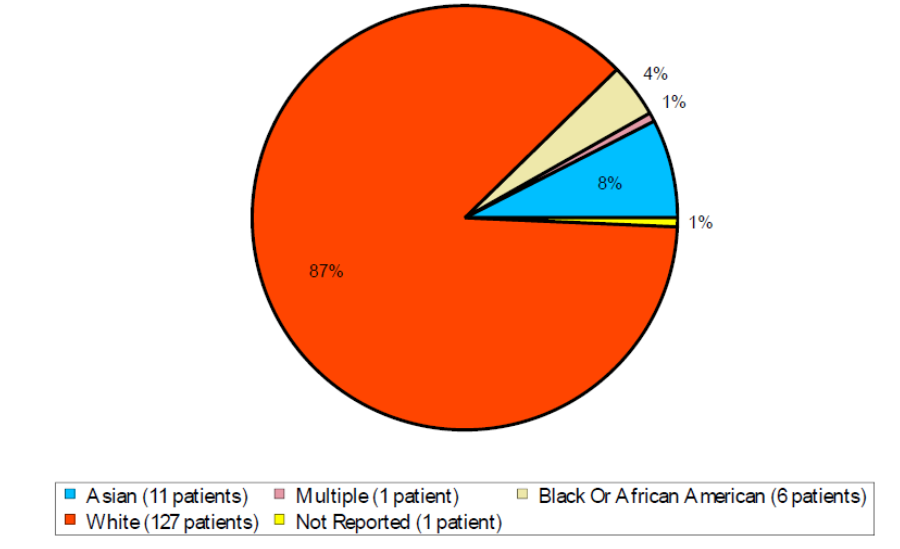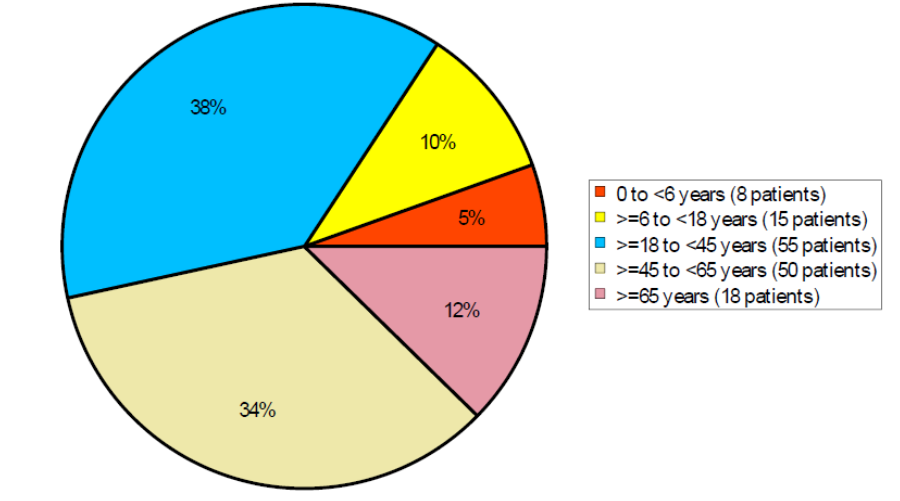Drug Trials Snapshot: NEXVIAZYME
HOW TO USE THIS SNAPSHOT
The information provided in Snapshots highlights who participated in the key clinical trials that supported the original FDA approval of this drug, and whether there were differences among sex, race, age, and ethnic groups. The “MORE INFO” bar shows more detailed, technical content for each section. The Snapshot is intended as one tool for consumers to use when discussing the risks and benefits of the drugs.
LIMITATIONS OF THIS SNAPSHOT:
Do not rely on Snapshots to make decisions regarding medical care. Always speak to your healthcare provider about the benefits and risks of a drug.
Some of the information in this Snapshot is for presentation purposes and does not represent the approved conditions of use of this drug. Refer to the NEXVIAZYME Prescribing Information for all of the approved conditions of use of this drug (e.g., indication(s), population(s), dosing regimen(s), safety information).
Snapshots are limited to the information available at the time of the original approval of the drug and do not provide information on who participated in clinical trials that supported later approvals for additional uses of the drug (if applicable).
NEXVIAZYME (avalglucosidase alfa-ngpt)
(nex vye’ a zyme)
Genzyme Corporation
Original Approval date: August 6, 2021
DRUG TRIALS SNAPSHOT SUMMARY:
What is the drug for?
NEXVIAZYME is an enzyme used for the treatment of patients 1 year of age and older with late-onset Pompe disease (LOPD).
Pompe disease (also known as lysosomal acid alpha-glucosidase [GAA] deficiency) is a rare disease caused by deficiency or decreased levels of the lysosomal enzyme, alpha glucosidase, which breaks down glycogen (a complex sugar). Glycogen can build up in organs and tissues, especially muscles, causing them to break down. There are two forms of this disease: infantile-onset Pompe disease (IOPD) and LOPD.
How is this drug used?
NEXVIAZYME is given by a health care professional through a needle placed in a vein (known as intravenous infusion) every 2 weeks.
Who participated in the clinical trials?
NEXVIAZYME’s safety data was obtained from 4 clinical trials (Trial 1/NCT02782741, Trial 2/NCT01898364, Trial 3/NCT02032524, Trial 4/NCT03019406). These trials enrolled 124 patients with LOPD and 22 patients with IOPD. The patients were from 22 countries around the world, including the United States. NEXVIAZYME was evaluated in 4 trials of 146 patients with Pompe disease.
Trial 1 evaluated the benefits and side effects of NEXVIAZYME, and all 4 trials evaluated the side effects of NEXVIAZYME,; therefore;, the number of patients representing efficacy findings may differ from the number of patients representing safety findings due to different pools of study participants analyzed for efficacy and safety.
What are the benefits of this drug?
Like the active comparator drug, NEXVIAZYME improved the lung function and the walkable distance in patients 1 year of age and older with LOPD after 49 weeks of treatment.
What are the benefits of this drug (results of trials used to assess efficacy)?
Table 1. Results for FVC (% Predicted) and 6MWT in Patients with LOPD (Trial 1)
|
|
NEXVIAZYME |
Active Comparator |
Difference[1] |
|---|---|---|---|
|
Change in FVC (% Predicted) |
|||
|
Change from baseline to Week 49 |
|||
|
Mean (SD) |
3.0 (6.8) |
-0.0 (5.8) |
|
|
Median |
3.2 |
-0.8 |
|
|
Min, Max |
-24.1, 19.4 |
-13.3, 14.1 |
|
|
LS mean change[2] |
2.89 (0.88) |
0.46 (0.93) |
2.43 (-0.13, 4.99) |
|
Change in Distance walked in 6MWT (in meters) |
|||
|
Change from baseline to week 49 |
|||
|
Mean (SD) |
37.9 (52.8) |
-1.7 (85.2) |
|
|
Median |
29.6 |
16.0 |
|
|
Min, max |
-31.0, 262.9 |
-394.0, 193.0 |
|
|
LS mean change[3] |
32.31 (9.93) |
2.19 (10.40) |
30.01 (1.33), 58.69) |
[1] Estimated difference (avalglucosidase alfa – active comparator) and 95% confidence interval
[2] Least squares (LS) mean change from baseline to week 49 estimated by mixed model for repeated measures (MMRM) including treatment, visit, treatment-by-visit interaction, baseline FVC (% predicted), age (continuous), and gender; an unstructured covariance matrix was used.
[3] LS mean change from baseline to week 49 estimated by mixed model for repeated measures (MMRM) including treatment, visit, treatment-by-visit interaction, baseline 6MWT, baseline FVC (% predicted), age (continuous), and gender; an unstructured covariance matrix was used.
Abbreviations: FVC, forced vital capacity; 6MWT, 6-minute walk test; LOPD, late onset Pompe disease; CI, confidence interval; SD, standard deviation; LS, least squares; mITT, modified intent-to-treat
Were there any differences in how well the drug worked in clinical trials among sex, race and age?
- Sex: NEXVIAZYME worked similarly in males and females.
- Race: Almost all patients in the trials were White. Differences in response to NEXVIAZYME among races could not be determined.
- Age: NEXVIAZYME worked similarly in all age groups studied.
Were there any differences in how well the drug worked in clinical trials among sex, race, and age groups?
Table 2. Subgroup Analysis of Change from Baseline to Week 49 in FVC (% Predicted)
|
Subgroup |
NEXVIAZYME |
Active Comparator |
Difference |
|---|---|---|---|
|
Overall |
51/2.89 |
49 (0.46) |
2.43 (-0.13, 4.99) |
|
Age (year) |
|||
|
18 to <45 |
23/3.78 |
19/0.80 |
2.99 (-1.52, 7.49) |
|
≥45 |
27/2.32 |
30/-0.14 |
2.46 (-0.84, 5.77) |
|
Sex |
|||
|
Female |
24/4.20 |
24/1.15 |
3.06 (-0.77, 6.88) |
|
Male |
27/1.64 |
25/-0.32 |
1.96 (-1.70, 5.63) |
|
Race |
|||
|
White |
47/2.77 |
47/0.48 |
2.29 (-0.39, 4.97) |
Abbreviations: FVC, forced vital capacity; CI, confidence interval
The trials were too small to support reliable subgroup analyses by race, age, and sex.
What are the possible side effects?
NEXVIAZYME may cause serious side effects such as hypersensitivity reactions and infusion associated reactions because NEXVIAZYME is an enzyme replacement therapy.
What are the possible side effects (results of trials used to assess safety)?
Table 3. Most Common Adverse Reactions* in Patients with LOPD**
|
Adverse Reaction |
NEXVIAZYME |
Active Comparator |
|---|---|---|
|
Headache |
11 (22%) |
16 (33%) |
|
Fatigue |
9 (18%) |
7 (14%) |
|
Diarrhea |
6 (12%) |
8 (16%) |
|
Nausea |
6 (12%) |
7 (14%) |
|
Arthralgia |
5 (10%) |
8 (16%) |
|
Dizziness |
5 (10%) |
4 (8%) |
|
Myalgia |
5 (10%) |
7 (14%) |
|
Pruritus |
4 (8%) |
4 (8%) |
|
Vomiting |
4 (8%) |
3 (6%) |
|
Dyspnea |
3 (6%) |
4 (8%) |
|
Erythema |
3 (6%) |
3 (6%) |
|
Paresthesia |
3 (6%) |
2 (4%) |
|
Urticaria |
3 (6%) |
1 (2%) |
*Reported in at least 6% of pediatric and adult patients with LOPD receiving NEXVIAZYME and at a higher incidence than in patients receiving active comparator
** NEXVIAZYME Prescribing Information
Abbreviations: LOPD, late onset Pompe disease
Were there any differences in side effects of the clinical trials among sex, race, and age?
- Sex: The occurrence of side effects was similar in males and females
- Race: Almost all patients in the trials were White. Differences in side effects among races could not be determined.
- Age: Very few patients were >65 years of age. Therefore, differences in side effects among different ages could not be determined.
Were there any differences in side effects of the clinical trials among sex, race, and age groups?
The trials were too small to support reliable subgroup analyses by race, age, and sex.
DEMOGRAPHICS SNAPSHOT
Figure 1 summarizes how many males and females were enrolled in the clinical trials used to evaluate NEXVIAZYME.
Figure 1. Baseline Demographics by Sex (Safety Population - Trial 1,2,3,4)
Figure 2 summarizes how many patients by race were in the trials used to evaluate NEXVIAZYME.
Figure 2. Baseline Demographics by Race (Safety Population - Trials 1,2,3,4)
Figure 3. Baseline Demographics by Age (Safety Population – Trials 1, 2, 3, 4)
The efficacy of NEXVIAZYME was evaluated using Trial 1 (N =100; NEXVIAZYME =51, Active Comparator = 49).
Who participated in the trials?
Table 4. Baseline Demographics of Enrolled Patients in the Clinical Trials
|
Demographic Parameters |
Trial 1 |
Trials 1, 2, 3, and 4 |
|
|---|---|---|---|
|
Sex |
|||
|
Female |
48 (48) |
70 (48) |
|
|
Male |
52 (52) |
76 (52) |
|
|
Race |
|||
|
Asian |
3 (3) |
11 (8) |
|
|
Black or African American |
3 (3) |
6 (4) |
|
|
Multiple |
0 |
1 (1) |
|
|
Not reported |
0 |
1 (1) |
|
|
White |
94 (94) |
127 (87) |
|
|
Age |
|||
|
Mean (years) |
48.1 |
41 |
|
|
Median (years) |
48.5 |
43.5 |
|
|
Min, max (years) |
16.5, 78.2 |
1, 78.2 |
|
|
Age group |
|||
|
>6 months to <1 year |
0 |
0 |
|
|
1 to <6 years |
0 |
8 (6) |
|
|
≥6 to <18 years |
1 (1) |
15 (10) |
|
|
≥18 to <45 years |
41 (41) |
55 (38) |
|
|
≥45 to <65 years |
40 (40) |
50 (34) |
|
|
≥65 years |
13 (13) |
18 (12) |
|
|
Region |
|||
|
United States |
32 (32) |
52 (36) |
|
|
Rest of the World |
68 (68) |
94 (64) |
|
How were the trials designed?
NEXVIAZYME was evaluated in 4 trials of 146 patients with Pompe disease. Trial 1 evaluated the benefits and side effects of NEXVIAZYME, and all 4 trials evaluated the side effects of NEXVIAZYME.
In Trial 1, patients received either NEXVIAZYME or another drug (called the active comparator) intravenously once every 2 weeks for 49 weeks. Neither the patients nor the healthcare providers knew which treatment was being given until after week 49. Patients in this trial were followed for a up to 5 years.
The benefit of NEXVIAZYME was evaluated by comparing the change in lung function and distance walked between patients who received NEXVIAZYME to the change in patients who were treated with the active comparator.
How were the trials designed?
The efficacy and safety of NEXVIAZYME were evaluated in Trial 1 of 100 treatment-naive patients 16 years of age and older with LOPD. The safety of NEXVIAZYME was also evaluated in 2 additional trials of patients with LOPD and 1 trial of patients with IOPD.
Trial 1 was a randomized, double-blind, active comparator-controlled trial where patients received 20 mg/kg of NEXVIAZYME or active comparator intravenously once every 2 weeks for 49 weeks followed by an open label phase in which all patients received NEXVIAZYME for up to 5 years.
The benefit of NEXVIAZYME was evaluated by comparing the change in forced vital capacity (% predicted), and distance walked on the 6-minute walk test between patients who received NEXVIAZYME to the change in patients who were treated with the active comparator.
GLOSSARY
CLINICAL TRIAL: Voluntary research studies conducted in people and designed to answer specific questions about the safety or effectiveness of drugs, vaccines, other therapies, or new ways of using existing treatments.
COMPARATOR: A previously available treatment or placebo that is compared to the actual drug being tested.
EFFICACY: How well the drug achieves the desired response when it is taken as described in a controlled clinical setting, such as during a clinical trial.
PLACEBO: An inactive substance or “sugar pill” that looks the same as, and is given the same way as, an active drug or treatment being tested. The effects of the active drug or treatment are compared to the effects of the placebo.
SUBGROUP: A subset of the population studied in a clinical trial. Demographic subsets include sex, race, and age groups.



